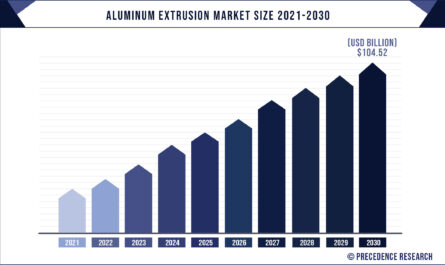Building and construction plastic Market Size 2022-2030, Market Share Analysis, Growth, Trends, Covid 19 Outbreak Impact Research Report Added by Precedence Research.
The global building and construction plastic market size is projected to hit USD 209.68 billion by 2030. Furthermore, the CAGR from 2022 to 2030 is positioned to be at a CAGR of 7.5%.
The report contains 150+ pages with detailed analysis. The base year for the study has been considered 2021, the historic year 2017 to 2020, the forecast period considered is from 2022 to 2030.
Download FREE Sample of This Strategic Report with TOC, Graphs & List of Figures @ https://www.precedenceresearch.com/sample/1298
Plastics are rapidly being used in an extensive range of building & construction applications such as insulation, window frames, piping, and interior design. Building and construction plastic is a plastic polymer that is used for obtaining the products for construction industry. For instance, polyvinyl chloride (PVC) sidings are the most well-popular plastic product used in the building construction industry. These type of plastics are mainly popular due to their ease of installation, low maintenance, durability, and low cost. In addition to this, numerous forms of plastic composites such as wood plastic composite (WPC), stone plastic composite (SPC),and luxury vinyl tiles (LVT) are less expensive and durable option for the flooring solution.
Crucial factors accountable for market growth are:
- Upsurge in residential and non-residential construction activities
- Increase in demand for plastics owing to low cost
- A lucrative physical properties such as high strength, easy to transport, and light in weight
- Significant growth in population
- A number of government initiatives to enhance building structures
- Rising trend of usage of recycled plastics in construction
Market Dynamics
Driver
Growth of the global building and construction plastic market is mainly driven by upsurge in residential and non-residential construction activities. For instance, according to the statistics Canada, total investment in building construction increased 5.9% to $18.6 billion in March, primarily led by the residential sector.
Restraint
There is rising trend of green buildings owing to its environmental, economic and social benefits. However, green building manufacturing prohibits use of PVC productsas they are non-biodegradable material and if burned, releases toxic fumes. For instance, PVC packaging has been restricted or banned in countries such as Canada, South Korea, Spain, and the Czech Republic. Hence, prohibition to use PVC products in green buildings may hamper growth of the market during the forecast period.
Opportunity
There is risingusage of recycled plastics in construction industry as recycling of plastics is helping to save energy and landfill space. In the construction sector, recycled plastics are being used to produce bricks, plastic lumber, roof tiles, and other useful elements for building. Hence, rising usage of recycled plastics significantly creates lucrative growth opportunities for the market growth during the forecast period.
Challenges
Weather ability of plastic building materials has been one of the key challenges to the global building and construction plastic market. For instance, exposure to the external environment may lead to degradation of plastic building materials and if not handled properly, it might cause significant economic loss.
Regional Snapshots
North America accounted the global building and construction plastic market in 2020 and projected to augment the market in the coming years due to rapid expansion of construction sector across the countries such as Canada and the U.S. In addition to this, ongoing trend of renovation of old buildings is projected to encourage market growth in these regions. Furthermore, increasing demand for commercial building and government investments across the public infrastructure expected to boost the demand in upcoming years.
Asia Pacific projected as the most opportunistic region during the forecast period. The growing population and rapid urbanization in the countries such as China and India has led to rise in infrastructure spending. Moreover, China is the major producer of polyurethanes and thermoplastics plastic materials.
Competitive Intelligence
The building and construction plastic market report provides an understanding of the market composition and explains the role of established players and regional contributors. It is essential for the market players to make calculative moves and focus on client acquisition and retention. The detailed company profiles will provide the necessary intelligence to the reader. In order to maintain their share, the market players are focusing on strategies such as cross-border expansion, product differentiation, and so on.
Some of the key players in the global building and construction plastic market include:
- BASF SE
- DowDuPont Inc.
- Koninklijke DSM N.V
- Chevron Phillips Chemical Company, LLC
- LG Chem Ltd.
- LyondellBasell Industries Holdings B.V.
- INEOS Group Holdings S.A.
- LanxessAktiengesellschaft
- SABIC
- Solvay S.A.
Segments Covered in the Report
By Product
- Polyvinyl Chloride
- Polystyrene
- Polyethylene
- Polyurethanes
- Others
By Application
- Roofing
- Polyvinyl Chloride
- Polyurethanes
- Others
- Insulation
- Polystyrene
- Polyurethanes
- Others
- Pipes & Ducts
- Polyvinyl Chloride
- Polystyrene
- Polyethylene
- Others
- Wall Coverings
- Polyvinyl Chloride
- Others
- Windows
- Polyvinyl Chloride
- Polyurethanes
- Others
- Others
- Polyvinyl Chloride
- Polystyrene
- Polyethylene
- Polyurethanes
- Others
By Geography
- North America
- U.S.
- Canada
- Europe
- U.K.
- Germany
- France
- Asia Pacific
- China
- India
- Japan
- South Korea
- Rest of the World
Purchase Full Research Report (Single User License US$ 4500) @ https://www.precedenceresearch.com/checkout/1298
About Us
Precedence Research is a worldwide market research and consulting organization. We give unmatched nature of offering to our customers present all around the globe across industry verticals. Precedence Research has expertise in giving deep-dive market insight along with market intelligence to our customers spread crosswise over various undertakings.
Contact Us:
Precedence Research
Call: +1 9197 992 333
Email: sales@precedenceresearch.com
Address: Apt 1408 1785 Riverside Drive Ottawa, ON, K1G 3T7, Canada

